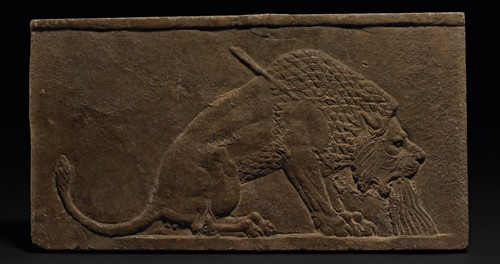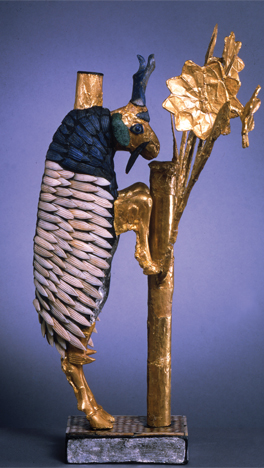Between the rivers
Mesopotamia and its influence on the modern world
 Dying Lion wall-panel relief, gypsum, 645-640 BCE, Nineveh, North Palace, H: 16.5 cm, w: 30.6 cm, d: 2.5 cm, BM 1992, 0404.1, Assyria, © The Trustees of the British Museum
Dying Lion wall-panel relief, gypsum, 645-640 BCE, Nineveh, North Palace, H: 16.5 cm, w: 30.6 cm, d: 2.5 cm, BM 1992, 0404.1, Assyria, © The Trustees of the British Museum
When planning a trip to visit Mesopotamia: Inventing Our World, currently at the Royal Ontario Museum (ROM), make sure the first thing on your checklist is time—a lot of time. This fascinating exhibit, running until January 5, 2014, provides so much intriguing information and aesthetic pleasure that a quick run through just won’t do it justice.
There are over 170 Mesopotamian artifacts on loan from the British Museum, and they have never been seen in Canada. The focus is on the emergence of cities and states in ancient Sumer (4000–2000 BCE), the Assyrian World Empire (1000–600 BCE), and the rise and fall of Babylon (600–540 BCE).
Mesopotamia, the Ancient Greek name for “land between rivers,” was located between the Tigris and Euphrates rivers, a region that encompasses presentday Iraq. It was here, over 6,000 years ago, that the people of Mesopotamia developed visionary ideas—including writing, city structures and agricultural techniques—that would influence the modern world.

Early administrative tablet, clay, 3300-3000 BCE, Uruk, h: 8.5 cm, w: 7 cm, d: 2 cm, BM 140854, Sumer, © The Trustees of the British Museum
Who would have thought, for example, that one of the first displays in the exhibit includes an iPad? That’s right, there is a comparison between a Sumerian clay tablet from 2033 BCE and iPad from 2013 CE. Although obviously very different, the idea of a rectangular object, full of information and fitting into the palm of a hand, is just one example of the thread that runs between Mesopotamia and today’s world.
The dots and curves carved on a clay tablet with a blunt reed are what we now call cuneiform. The word derives from the Latin cuneus (wedge) and forma (shape) and is the first record of writing. It was originally used for official temple bookkeeping, and scribes also wrote down legal agreements. The pieces on display appear as intricate designs made of marks and grooves.
The artifacts become more sophisticated with the introduction of cylindrical seals, also used for record-keeping. The little cylinders, made of material such as serpentine, were decorated with scenes like important banquets. If you rolled the cylinder onto a piece of damp clay, the scene appeared on the flattened slab.

Ram in a Thicket (side view), gold, silver, lapis lazuli, copper, shell, red limestone, bitumen, c. 2650-2550 BCE, Iraq, Ur, h: 42.5 cm; w: 28 cm, Sumer, Courtesy of the University of Pennsylvania Museum of Archaeology and Anthropology, Philadelphia, P.A.
One of the exhibition’s highlights is Ram in a Thicket, a figure of a rearing goat made of gold, silver, lapis lazuli and shell from c. 2500 BCE. It is the twin of a figure uncovered during an excavation in 1928-29. The piece will only be shown in the first half of the exhibit’s run. It will be substituted in the second half by a lyre dating from 2650-2550 BCE, made of gold, lapis and shell, and adorned with a bull’s head and mythical scenes.
After the 14th century BCE Assyria emerged as a major political and military power and grew to control an area covering Iraq, Syria, Israel, Egypt, parts of Iran and Turkey by around 660 BCE. The exhibit has an area showcasing video footage of the 19th-century archeological dig that uncovered the Assyrian empire, including the ancient cities of Nimrud, Khorsabad and Nineveh.
A fabulous part of the exhibit is the way in which it displays the Assyrian carved stone reliefs, most of which are from Nimrud and Nineveh. Assyrian cities were full of large palaces enhanced by these reliefs. Formed of gypsum, the intricate carvings tell stories that highlight the kings’ achievements. Visitors can watch colour vignettes that depict the imagined scene prior to the final product carved in stone. These animations, with accompanying sound effects, are beautifully and creatively composed, and greatly add to the experience when looking at the actual reliefs.

Head of a woman with full Egyptian hairstyle, ivory, 9th-8th century BCE, Nimrud (Kalhu), Burnt Palace, h: 6.1 cm, w: 6 cm, d: 6.1 cm, BM 118186, Assyria, © The Trustees of the British Museum.
With a curricular link to Grade 11: World History before 1600 (CHW3M), teachers can arrange for students to be led through the exhibit by ROM facilitators, who will take them on a journey through 3,000 years of human history and show how the innovations of Mesopotamia continue to impact our lives. One-hour tours for secondary students are held on weekdays from 10:00 a.m.–12:00 p.m. and 12:30 p.m.–2:00 p.m. For more information call 416.586.5801 x 1.
For hours and more information, please visit rom.on.ca.

Leave a comment